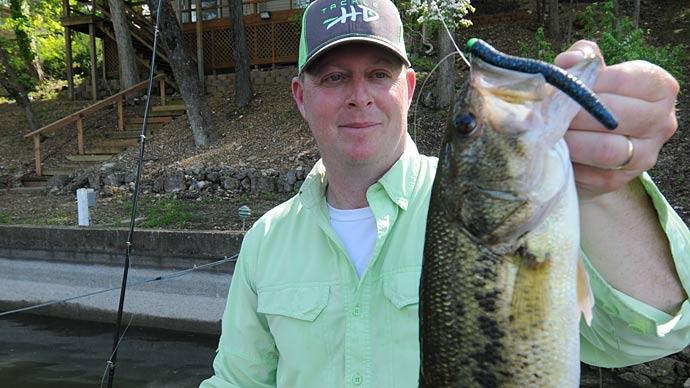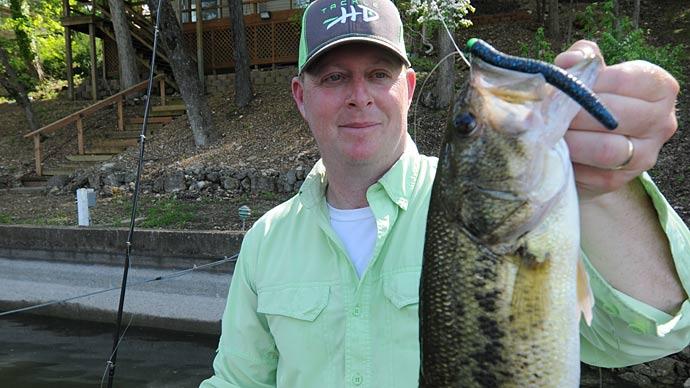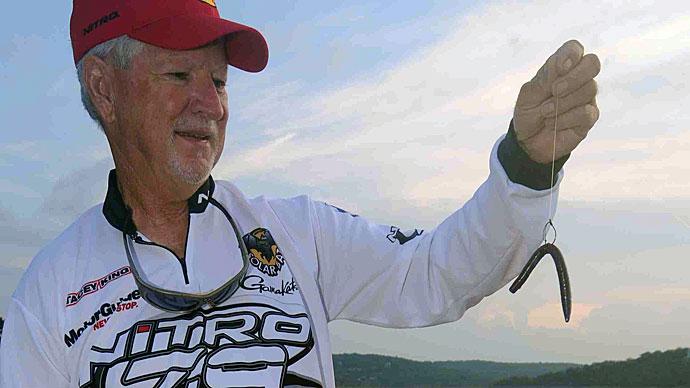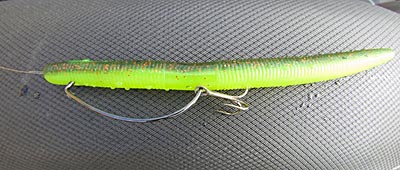
A Yamamoto Senko sure does a lot for a bait that looks like nothingYamamoto Senko sure does a lot. Many pro fishermen will tell you that a Senko is one of their top money-makers. Senkos come in various sizes and colors and can be rigged and fished in many ways. Here are some tips to get you started with this fantastic bait. Although there are plenty of knock-offs and cheaper versions, only a Yamamoto Senko has that texture, saltiness, and jiggle that made it a favorite bait.
Wacky Rig A Senko
Wacky rigging a Senko means sticking the hook through the middle of the bait instead of the end. So rather than sticking the hook in, turning it around, and re-inserting it like a Texas rig, you stab the hook through the middle of the bait and leave it exposed, with the tail and head of the Senko dangling. There are several ways to wacky rig a Senko that don’t involve stabbing it through the center – mainly developed to make the bait last longer. Silicone bands like the ones made by VMC require a special pair of pliers that hold the band open while you slip the bait. With these, you slip the hook under the band, and the Senko doesn’t get a hole. There are also rubber O-rings with or without a secondary ring for the hook. These both work better on the shorter Senkos because, with the longer baits, the ends sometimes flop over and get caught on the hook.
Most anglers fish a wacky-rigged Senko on spinning gear with braid and a mono or fluorocarbon leader. There are lots of special wacky rig hooks, but almost any hook will work, although the rounded hooks like drop shot hooks are favored. Ensure the hook bend is large enough to go through the bait and still has enough out to hook the bass.
To fish a wacky-rigged Senko, you cast it out to the shore and twitch it a bit as it falls. You'll get fewer snags if you reel it back in before it hits bottom. This technique is dynamite in ten feet or less – if you want to go heavier, you can put a nail weight in one or both ends to make it get down a little quicker. I’ve known guys targeting very deep fish with a wacky-rigged Senko. See it on the graph, and drop down to it. For some reason, in Arizona, the bass seem to love it when the water rises and floods the cockleburs. You can fish a Senko in those things and catch fish all day long. Of course, you also snag a lot of cockleburs, but it sure is fun.

You don’t have to waste a lot of time in one spot – the action that the wacky-rigged Senko creates will draw fish, so if you don’t get bit, move on. Once you start shaking the Senko down, you’ll learn what it feels like in a short time. When it feels solid instead of twitchy, set gently by tugging the rod to the side while reeling.
Spawning Fish
Bed fish are often pressured and savvy. Fishermen race to the beds and sit there for long periods, trying to temp a fish into biting. If a storm moves in, they’re toast. On the other hand, a Senko fisherman can just run down the bank and throw onto flats and the backs of coves and never be seen by the fish. You aren’t targeting bedding fish, but you’ll catch some. I’ve never been a fan of bed fishing, but I never mind running the banks with a Senko. Just wacky rig it and fish it shallow.
An old friend named Jim Furr got drawn in a tournament with Skeet Reese one spring years ago, and Skeet was bed fishing. Furr caught sixteen pounds while Skeet was working on one-bed fish. When it was his turn to take the front, he went to the tules and caught a six-, a five-, and a four-pounder while the cameras were rolling. He said they had guys begging them for baits. He was pitching the Senkos to holes in the tules and letting it sink. The line would feel heavy and boom – another bass. Jim says he had a limit of 40 minutes every day and was the only guy in 12 tournaments to make Skeet take the back of the boat. He says Fish Fishbourne was interviewing him on stage and said, “I’m not even going to ask you what you’re fishing. Does it start with an ‘S’”? Seriously, Senkos are that good.
Texas Rig a Senko
Once you start getting into submerged or emergent trees and brush, a wacky rig can start to hang up almost constantly. There are weedless wacky rig hooks, but I find it easier to rig the Senko Texas with no weight. Senkos are pretty weighty all by themselves, and using an additional weight changes the action. If you are having difficulty getting it to fall through the branches, try using a nail weight in the end. Pitch or flip the Senko and let it fall. I usually start outside the cover, and if I don’t get bit, I move inside. The bite can be a big tug, a little twitch, or simply a heaviness when you try to retrieve the bait. If you do this enough, you’ll get a feel for it. It’s easier to get the lure back if they bite on the outside, but they don’t always cooperate. Another way to get a Senko to fall through more efficiently is to use a Sinkerstopper. These are made to keep sinkers and bobbers in place, but putting one in front of your hook also helps guard the knot and allows the bait to fall better without getting hung up.
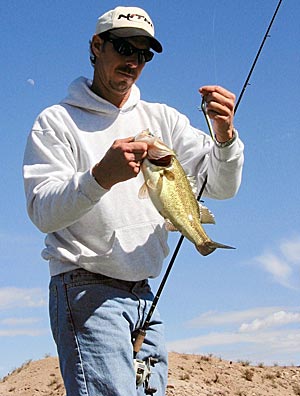
Carolina Rig
When bass are deeper or moving from deep to shallow and back, one productive way to fish a Senko is to Carolina rig it. You can wacky rig the Senko, or you can rig it Texas and weedless. You need a long stout rod with some to give a tip for slinging the bait out. I like to use braid for Carolina rigging because often you have a lot of line out, and it’s just easier to set the hook with braid. But if you’re fishing clear water, you’ll probably want to use a fluorocarbon leader. You’re going to have a leader in any case unless you use a rubber worm for pegging a sinker on your line. So slip a nice heavy sinker onto your main line – I usually use a ¾-ounce egg sinker – then a bead to protect the knot from the sinker. They can get some sharp edges around the hole. Then tie on a good swivel. Attach your leader to the other end of the swivel. The rule of thumb is that the slower the bite, the longer the leader. I usually use about a 4-foot leader with a Senko, shorter if the fish are active. Using tungsten weights with fluorocarbon makes you feel things a lot better in deep water.
This is a slow way to fish. Find a nice channel or a ditch in a boat lane – those little cuts are the best, and fish feed there, particularly in the fall. Motor around and look for even a small sloping break, then fish the Senko along it lengthwise. Let the weight fall to the bottom, then wait a bit while the bait itself falls. You’ve seen how it falls up shallow, so you know how long it will take. Twitch it a bit – the Senko will dart up from the bottom and start going back down. It seems to take forever, but it’s an excellent technique for when the bite is tough. Once you’ve let it fall, jerk the whole rig up about four feet, then let the weight fall again and start all over. Make sure you reel up just enough to keep the line taut. When you rip the rig up, if it feels heavy, set the hook hard by swinging your rod quickly to the side while reeling. A fast reel is helpful.
Senko Colors
Don’t get too hung up on colors. You should be able to find a Senko that approximates the color of the primary baitfish in your area and will most likely be your go-to bait. Use a darker one in low light and a lighter one in full sun and for clear water. I love the laminate ones – my favorite is green pumpkin on one side and white on the other. That way, I don’t have to make up my mind. The holo baits are great in clear water as well. Remember that fishing is going to be darker down there when you are fishing deeper. The main thing is to pick a color that the fish can see. I honestly have not found a Senko that the fish won’t bite.
One last tip: never buy just a single bag of Senkos. They get torn up, and you’ll quickly go through a bag. Try a Wormizer or a ProWeld Wormizer if you want to make them last longer. You can get these at Iovino.com, and they weld your plastics back together. It takes time, but you can recoup the initial investment fairly quickly. The Wormizer is around $30, and the ProWeld Wormizer is $60. That buddy of mine I mentioned before – Jim Furr? He said when he had the front of the boat, he’d throw his broken Senkos on the floor, and his non-boater welded them with a Wormizer and caught limits on them daily.
Because it looks so simple, you might be fooled into thinking that you must be some artist with a lure to make a Senko work for you. But looks are deceiving. This bait has tons of action on its own and can help you put a lot of bass in the boat no matter what time of year you are fishing. You owe it to yourself to get a few bags and start throwing them. All you have to do is let it fall.
BassResource may receive a portion of revenues if you make a purchase using a link above.


